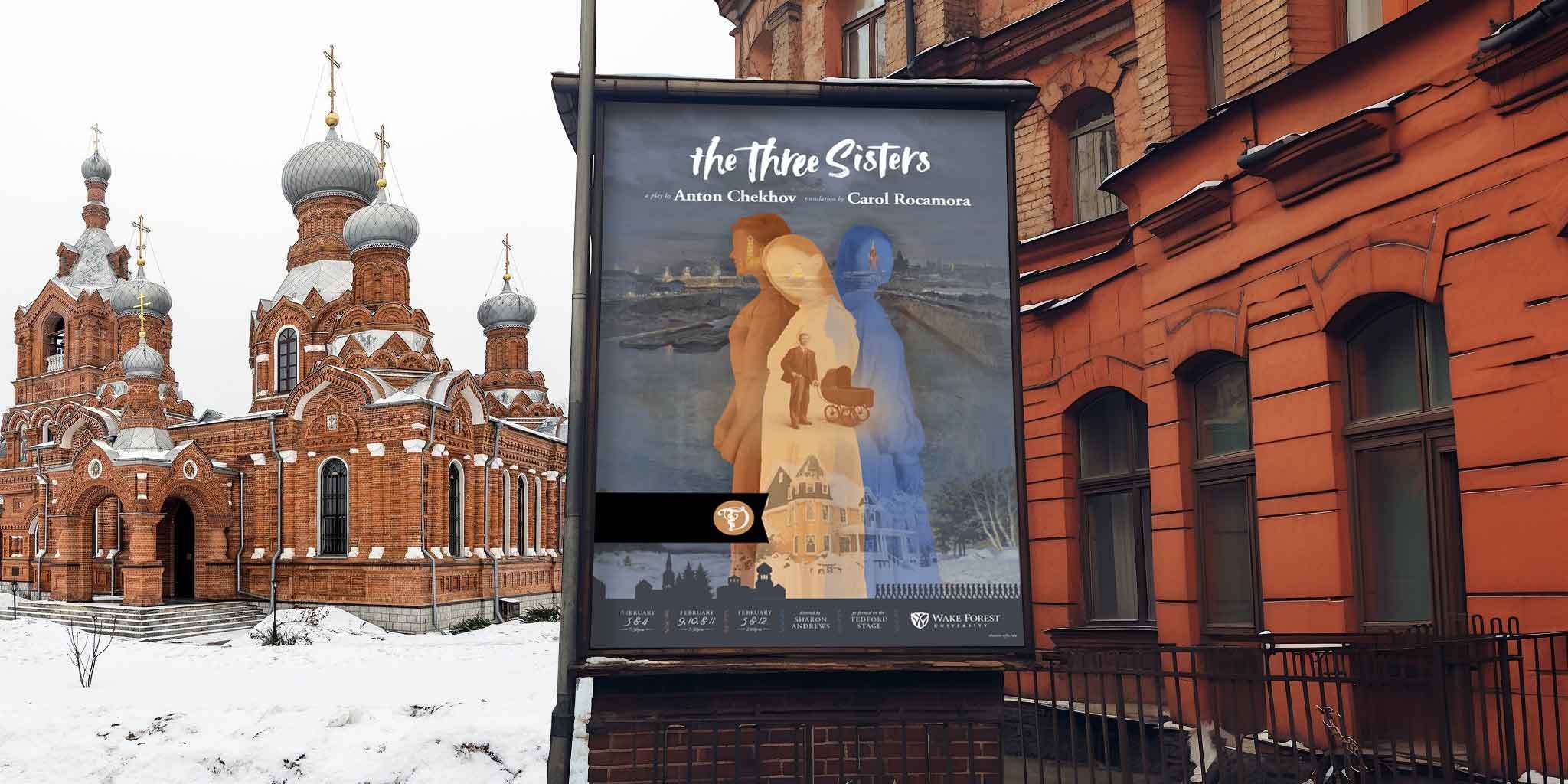Wake Forest Department Of Theatre & Dance
Based in the Scales Fine Arts Center on campus, the Department of Theatre & Dance plays an integral part in the Wake Forest University community. It fosters close working relationships between students and faculty as they explore the performing arts with a spirit of intellectual curiosity, innovation, and dialogue.
Each season, the Department produces four distinct plays, selected from the classics as well as modern playwrights. The Design Office of John Murph has had the privilege of coming alongside this effort to craft promotions for each production.
A form of “photomontage narrative” was employed for this series, with primary, secondary, and tertiary layers of meaning integrated into each composition. Each poster design is embedded with details that draw the viewer in, rewarding them with more details gleaned from the play’s plot. It’s all engineered to pique interest and reward study.
| Design |

“Beware the Ides of March . . .”
First performed in 1599, The Tragedy Of Julius Caesar is an undisputed classic. William Shakespeare’s recounting of the titular character’s downfall and Rome’s subsequent descent into civil war has been a mainstay of high school english classrooms for generations. For it's 2022-2023 Season, The Department Of Theatre & Dance presented a bold production of the signature play, marshaled with a modern setting and inspired by current events.
Hence, the Design Office Of John Murph presented a solution that balanced ancient and avant-garde. The impact and manipulation of the Media provided thematic imagery, like television screens and news broadsides. This was juxtaposed with static-filled images of war alongside clandestine backroom deals. Caesar himself is crowned with a laurel wreath formed from journalists’ microphones - each catching fire in mirrored fashion.


“Hearts . . . and stars . . . are blinding.”
"Silent Sky" tells the story of Henrietta Leavitt, a female astronomer working at the Harvard Observatory in the early 1900's . . . before women were even allowed to vote. Despite facing obstacles in what was a male-dominated field at the time (which included denying her access to telescopes), she discovered how to effectively measure vast celestial distances. This led to a revolutionary shift in scientists's understanding of the universe. “Silent Sky” is a beautiful story, balancing the intimate with the cosmic.
Our solution featured a warm silhouette of the main character set on a background of the starry Magellanic Clouds. Within her figure, the viewer can trace a visual narrative of her life’s journey, from stargazing on her family’s farm to a final, bittersweet triumph looking through Harvard’s refractory telescope. Orbiting around her silhouette are the faces of her friends and family, formed as constellations on the celestial backdrop.


“Thrice upon a time . . .”
A coming-of-age story told through a series of fairytale adventures, "This Girl Laughs, This Girl Cries, This Girl Does Nothing" is a modern day fable that provides a delightful allegory for growing into your own skin. Prompted by tragedy, three identical sisters embark on personal, 20-year journeys. Slowly but surely, through unlikely encounters and the odd wrong turn, each young woman takes on a maturity that makes her unmistakably distinct and unique.
The Design Office Of John Murph created a three stage echo of the girls' image to create a frame for each individual journey, told with a photomontage narrative. Within each girl's silhouette, one can trace their sojourn from beginning (at the base) to the end (at the top). To the viewer, this serves as a vehicle for intrigue that is rewarded upon seeing the play. The three figures are set on a subtle topographic background, creating a context for their adventures.


"How strangely life changes, how it deceives us!"
"Three Sisters," a play by the legendary Anton Chekhov, is a treatise that explores longing for the unattainable, the desire for that which we cannot have. The titular sisters are part of a larger cast of intricately woven relationships, fiery passions, and unfulfilled dreams set in Tsarist Russia. Chekhov's story finds its power in holding up a mirror to its audience - inviting us all to recognize our own foibles in the characters on stage. He exemplifies a paradoxical counterpoint to the 'heroic journey' that is so often the standard in fiction.
The overall composition features the three siblings (Olga, Masha, and Irina) superimposed on an Isaac Levitan Impressionist painting of Moscow - one of the key objects of their unattainable longing. Levitan was a contemporary and friend of Chekhov, and shared his philosophy of satirical realism. The posture of each sister mirrors their predicaments: resignation (Olga), forlorn longing (Masha), and short-lived curiosity (Irina). Superimposed over them is their brother, Andrey, whose emasculation compounds their struggles.


"Touching, isn’t it? The way he counts on his wife."
"Yes, like a drowning man clutching at a razor blade."
As the first installment for the department's 2023-2024 season, Agatha Christie's classic, Witness For The Prosecution, is a chilling whodunnit to warm your cockles. Christie's tale reminds us why she is a legend, as it weaves characters – all hopelessly British – together into a tangled web. Just when one thinks the primary suspect is unavoidably exposed, a twist lurches the story sideways, defying even the shrewdest literary sleuths.
Upon learning the director's intent to present the play with a shadowy film noir aesthetic, we followed suit. Embracing the collage narrative employed as a branded theme for all the department's promotions, this design was no exception. Composed of the black, white, and sepia tones of classic films from the era (think "The Big Sleep" or "Touch Of Evil"), the composition features the primary suspect, Romaine Vole. A spotlight slices across her cold gaze to highlight the story's victim slumped on the floor. Other elements of the play hide in plain sight (just like the clues that Christie leaves) as signposts for the viewer that only make sense when the curtain falls.

